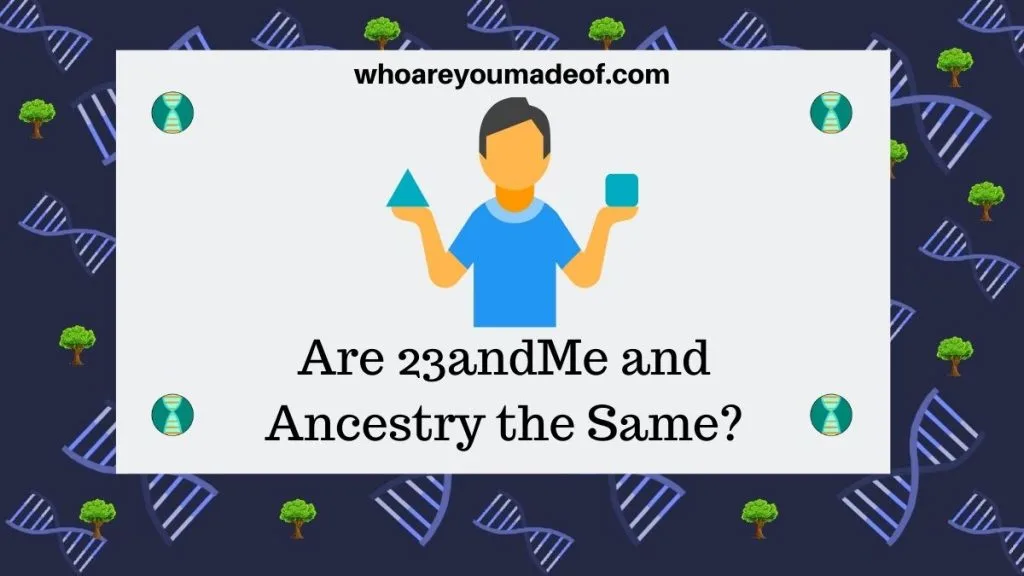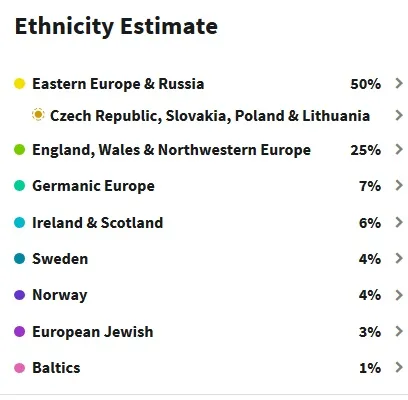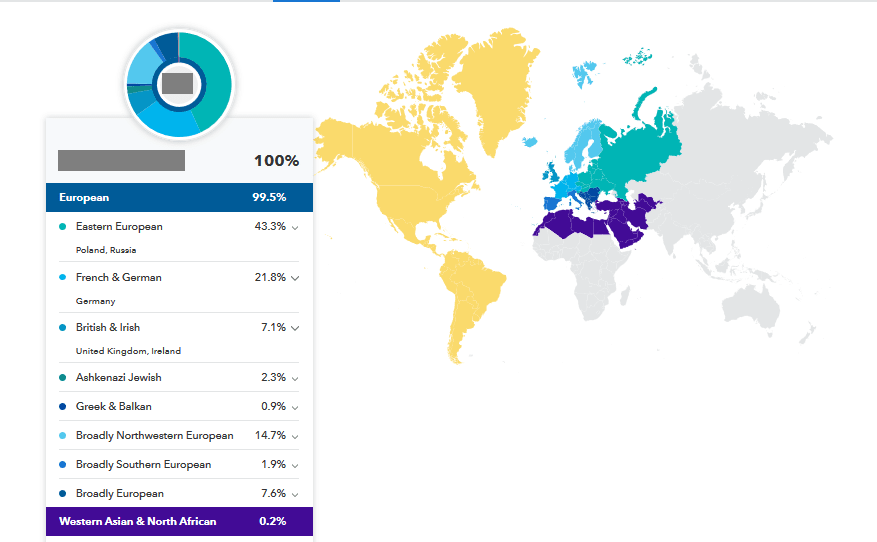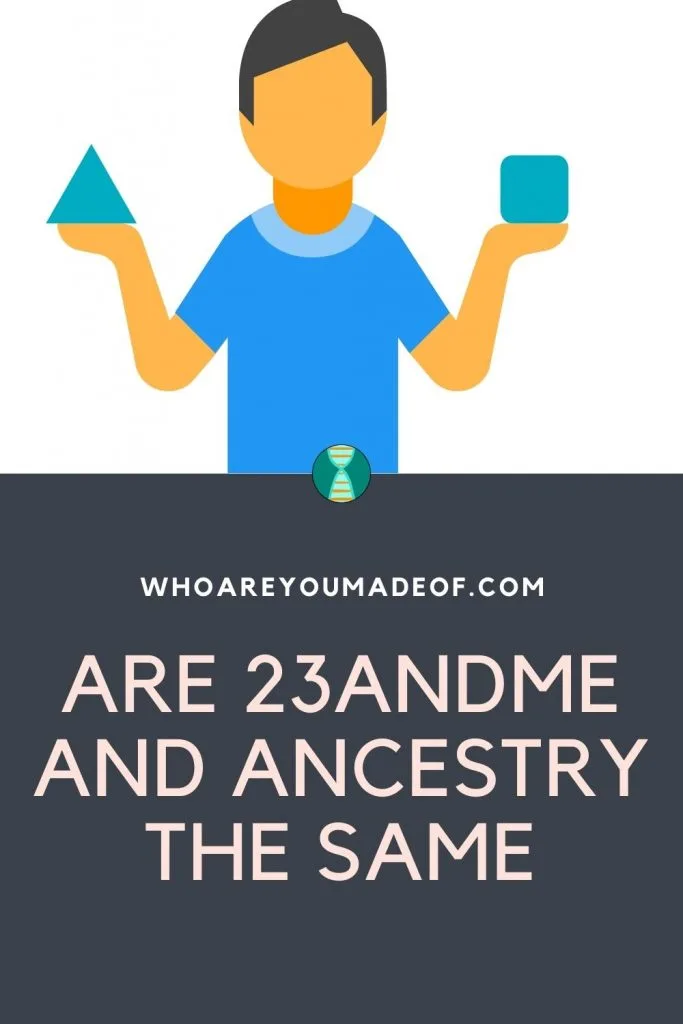Are you wondering if 23andMe and Ancestry DNA are the same? While they are similar tests, they offer different results. Find out which test is best for you in this post.
Whether you are trying to decide which test is best for you, or if you already tested with Ancestry DNA and wonder about 23andMe (or vice versa), you are sure to find the answers you are looking for here.

At first glance, the Ancestry DNA and 23andMe tests seem similar. There are important differences, however.
Below, I'll explain the ways in which the tests and the results are almost the same - as well as how they are very different.
How are the 23andMe and Ancestry results similar?
The Ancestry DNA and 23andMe tests, while different, do have some important similarities. For example, both of the tests examine autosomal DNA.
Autosomal DNA is the DNA that we inherit from each of our parents. This DNA is located on our 22 numbered chromosomes.
Both of these DNA tests are similarly priced and offer to tell us where our ancestors may have lived in the past few to several hundred years. Both sets of results can be used to help build a family tree, contact living relatives, and discover more about our family history.
23andMe and Ancestry both have user-friendly websites that allow us to explore our DNA results with ease. In addition, they both offer fun visual representations of our results, as you can see in the images below.
This is an example of the ethnicity estimate portion of Ancestry DNA results:

Example of 23andMe ancestry composition results:

As you can see, these results are very similar. Regions might have slightly different names or geographic borders, but the results have a lot in common.
Even so, they aren't exactly the same. Keep reading to find out how they differ.
Are 23andMe and Ancestry owned by the same company?
Even though there are similarities between 23andMe and Ancestry, these companies are not owned by the same individuals or organizations.
Ancestry, the parent company of Ancestry DNA, changed ownership in the summer of 2020. Once the deal is finalized, the ownership of the company will be 75% Blackstone, and investment firm, and 25% Singaporean Sovereign Wealth fund (GIC), a fund established by the Government of Singapore.
23andMe also has more than one owner. The most notable ownership stakes are held by Alphabet, which is the parent company of Google, GlaxoSmithKline and Sequoia Capital.
What are the main advantages of 23andMe and Ancestry DNA?
Aside from ownership, there are many important differences between Ancestry DNA and 23andMe. The differences between these companies are their advantages.
In other words, there are distinct advantages to testing with each company. This is the main reason that I recommend testing with both companies, if possible.
I know that this isn't practical for everyone, so if you must choose between these two tests, I hope this section is helpful to you.
Advantages of testing with Ancestry DNA over 23andMe
Ancestry DNA offers two main advantages of the 23andMe test: the biggest database of potential DNA matches and the ability to connect DNA results with a family tree on the the main Ancestry site.
More than 18 million people have done DNA tests with Ancestry DNA, which means that those of us who are looking for biological family or using DNA match information to build our family trees will find lots of information on our DNA match lists.
In addition, Ancestry DNA allows those customers who have tested their DNA to connect their family trees with their DNA results, allowing access to additional features. One of these features is Ancestry ThruLines.
Ancestry ThruLines is a helpful feature that compares our family tree with those of our DNA matches, as well as other family trees on Ancestry, in order to determine how me might be connected to our DNA matches. This feature can also identify potential new ancestors.
Advantages of testing with 23andMe over Ancestry
There are two main advantages that the 23andMe test offers: Y-DNA and mtDNA haplogroups and a chromosome browser. I'll discuss these two advantages in detail below.
The most important difference, in my opinion, is that 23andMe tests for Y-DNA and mitochondrial DNA (mtDNA) haplogroups. These can help you learn the origins of your direct paternal and maternal family lines.
Everyone inherits mtDNA from their mother. She inherited from her mother, who got it from her mother.
Y-DNA is only inherited by males. Males inherit Y-DNA from their father, who got it from his father, and so on.
Scientists are able to determine the origins of maternal and paternal lines, and you will be able to see this information on your 23andMe results. This can occasionally reveal surprise distant ancestry.
The second main advantage to 23andMe is the chromosome browser. This allows you to compare your DNA with that of your DNA matches in order to inspect important details about your shared DNA.
For example, you will be able to see the exact location on your chromosomes of DNA segments shared with your matches. This information can help you figure out how you are related to your DNA matches and learn more about your shared ancestry.
Is Ancestry DNA or 23andMe better?
Both Ancestry DNA and 23andMe provide a high-quality DNA test and excellent, reliable results. Even though each company provides its customers with results that are slightly different, they are both excellent choices.
In other words, you can't go wrong by testing with Ancestry DNA or 23andMe. It's all about exactly what you are hoping to achieve with your DNA test.
To learn even more details and see in-depth sample results from these two companies, check out these articles:

Conclusion
I hope that this post has helped you learn more about the important differences between the 23andMe and Ancestry DNA tests. Plus, I hope that you decide to test with one, or even both companies!
There is so much to learn from your DNA, and today is the best day ever to start your DNA journey.
If you have any questions about something that you read in this post, I'd love to hear from you in the discussion below.


Ralph Dane Looman
Monday 31st of August 2020
I was not aware that 23andme tested for, and displayed, the male Y - chromosome. Is this a relatively new feature, or have I just been blind to its offering? AND... is there a button or tab that can be pressed that will cause all of ones reported male dna matches that have an identical "Y-chromosome" match to be handsomely and automatically listed for the principal party? In other words, I'm an R-P258.2 haplo. Can I summons all other R-P258.2(s) and have them all listed for my review?
Mercedes
Monday 31st of August 2020
Hi Dane, I probably should have been more clear in my post - I am sorry. 23andMe doesn't sequence Y-DNA, but does report the Y-DNA haplogroup based on patterns seen within SNPs. You can see your Y-DNA and mtDNA main haplogroups on the main page of your 23andMe results. In other words, you get the general haplogroup, but not specific enough to do Y-DNA matching. At this point, the sequencing required to do useful Y-DNA matching is expensive (as you probably have noticed, having tested your Y-DNA). Perhaps someday we will have this feature with our autosomal results. I hope this answer helps! Sincerely, Mercedes